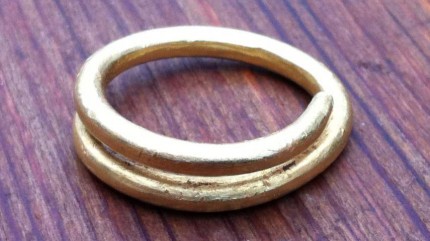
Camilla Lundin was walking through a field in the village of Gudhem in southern Sweden when she came across a pretty gold ring. It loops around itself once, so when she first found it she thought it was a spiral leg band for a chicken. Her husband didn’t think much of it either. It was her brother who identified it as an ancient artifact after she sent him a photograph of the ring.
“When he told me it was an ancient gold ring, it felt like a gift from the underworld,” Lundin told The Local. “It was my magnificent ring. I didn’t want to give it up.”
Because Swedish law requires that any potential archaeological artifact made out of gold, silver, or bronze must be reported to the state, Lundin reported the find to the Swedish National Heritage Board. The finder can keep anything more than a 100 years old, but the state gets first dibs on objects made out of precious metals. If the Board determines that it’s of sufficient historical significance to be of interest to them, the state pays the finder fair market value and keeps the artifact. Lundin didn’t want the money, though. She wanted to keep the ring.
The Board found the object was a 2,000-year-old gold ring from the Roman Iron Age. They wanted to explore the discovery site to see if there were any other pieces from the period in the field.
Lundin discovered the trinket in June 2011, but due to planting seasons the Board was unable to investigate the field until autumn. The research and paperwork took more than two years, but for Lundin it all paid off. After searching the farm for similar artefacts on two separate occasions, the state offered Lundin 11,000 kronor ($1,672) for the ring.
“I guess I knew right away it was special, but I had no idea just how valuable it was,” said Lundin, who confessed she still felt slightly disappointed to lose the ring. “I haven’t decided what to do with the money yet, but it will definitely be something special. Maybe I’ll travel somewhere.”
I love how she grudgingly took the money for it because the state compelled the sale but the treasure was worth so much more to her than its monetary value. In her place, I’d feel exactly the same way.